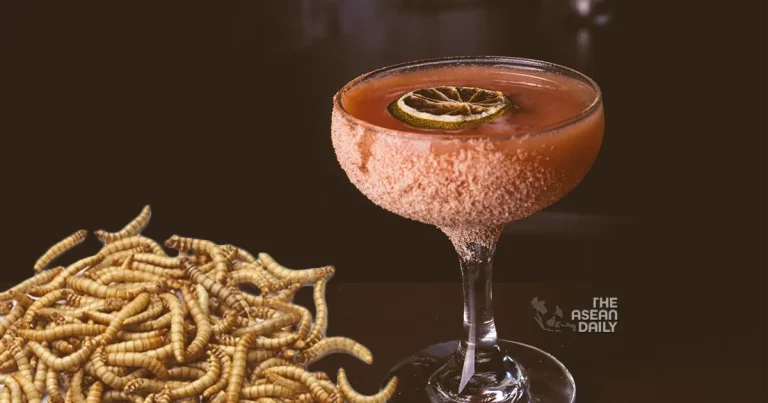16-9-2023 (SINGAPORE) If you were to take a sip of one of Fura’s cocktails, you might mistake it for a well-crafted libation in an upscale Singaporean bar. However, the seemingly simple drinks hide some surprising ingredients.
In place of olives, the martini boasts jellyfish and seaweed oil as its centerpiece. Another drink, appearing to highlight caviar, features tiny balls of black garlic instead of the precious roe.
Yet, the most attention-grabbing concoction is a margarita made with stir-fried mealworms.
These twists aren’t merely for shock value. Fura, a 60-seat establishment that opened its doors in early September, represents the latest experiment in one of the world’s most competitive drinking scenes. It seamlessly combines sustainability with sophistication, all while striving to remain profitable in Singapore, where costs, from raw materials to labor, have surged in recent years. Moreover, one of the most noteworthy components planned for the menu—insects—can’t legally be sold as food in the country yet.
Taking on this formidable challenge are Christina Rasmussen and Sasha Wijidessa, a couple under the age of 30 who have already made names for themselves in the hospitality industry. Rasmussen previously served as the head forager at Noma, the three-Michelin-star restaurant in Copenhagen. Wijidessa holds the position of Asia Commercial Director for the Danish spirit distillery Empirical, which is gaining international recognition for its unconventional alcohol blends.
They’re banking on Fura’s menu, which they describe as “a journal of future food,” to appeal to a new generation of environmentally conscious patrons. Cocktails at Fura start at S$24 ($18) and feature tongue-in-cheek names with unconventional flavors.
For instance, the “Caviar Papi” is designed to mock wasteful eaters and includes a faux version of caviar that imparts a garlicky taste and creamy texture to the drink. The jellyfish martini combines a distinct fishy flavor with hints of gin and salty seawater. “We are very specifically not trying to have any cultural cuisine tied to us,” explains Wijidessa. Fura, which means “pine” in Swedish, was conceived to place sustainability at the forefront. “We want to create a new ritual of eating and drinking that makes sense for now and in the future because our resources are different now.”
Even coffee beans were excluded as an ingredient in one of their cocktails due to concerns about the heavy water consumption associated with their cultivation. Instead, the pair opted for an alternative “espresso” made from malt grains.
Achieving sustainability while maintaining the necessary variety for a creative menu is a challenge in a small equatorial city-state like Singapore. The country imports over 90% of its food and lacks the temperate climate needed for cultivating exotic produce.
Fura has sought out local food sources, with a Singapore-based hydroponic farm supplying the majority of its vegetables. However, this hasn’t been without its challenges. Locally grown tomatoes don’t meet their taste standards, so they undergo lacto-fermentation with MSG for days before being used in a cocktail humorously named “Make Local Tomatoes Great Again.”
The ultimate test, though, will be the inclusion of multi-legged creatures on the menu. While consuming insects is not uncommon in Southeast Asia, selling them for consumption in Singapore is still prohibited. Authorities are expected to approve 16 insect species by the end of this year, likely with some restrictions. Wild-harvested bugs will not be allowed, and hazard analyses will have to be conducted. Some respondents expressed disgust at the thought of consuming insects during a public consultation last year.
None of this has deterred Fura’s founders. In anticipation of approval, they have sourced critters like grasshoppers and mealworms from a Thai farm and perfected dishes and drinks that will feature them. During a recent preview tasting, the insects were cleverly incorporated into the dishes and drinks, making them inconspicuous.
For instance, minced crickets were virtually undetectable in a vegetable dish called “Peas in Threes,” blending in with the other salty, crunchy components. In the “Get the Worm” cocktail, only a slight yellowish hue and an earthy flavor hinted at the mealworms that had been infused into the spicy, tangy margarita.
Rasmussen explains, “There are different ways of manipulating it where you’re not staring at bugs in the eye,” making it “familiar and tasty to most people.” They also plan to introduce a separate tasting menu that will boldly feature insects for more adventurous diners.
“Insect protein is something that we really want to work with because we think that’s kind of the next step,” says Wijidessa. “Singapore is a very young nation where you have a very big population that is open to change, so I am hopeful that it would pick up and become the norm.”
With a crowded cocktail scene that has expanded significantly in recent years, Fura faces little margin for error. New entrants include intimate venues like Night Hawk, styled after speakeasy bars, and extravagant establishments like Atlas Bar, boasting more than 1,300 types of gin showcased in a multi-story display tower.
Across the street from Fura is Native, a bar that opened in 2016, emphasizing regional produce. It’s one of the names that dominated this year’s ranking of Asia’s 50 Best Bars list from the World’s 50 Best organization, with over a fifth of the list hailing from Singapore.
Opening Fura has been far from straightforward, with delays and various challenges, including a three-month backlog in glassware deliveries and permitting issues. Rasmussen reflects, “I think most things that could have gone awry have gone awry.” However, both she and Wijidessa remain optimistic about what their sustainability focus may mean for their bottom line. “Fura is very personal for us; it’s an extension of who we are,” says Wijidessa. “Maybe we run on a thinner margin, but we have an Earth tomorrow.”




